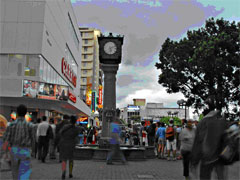.jpg)
Artist's Rendering of Costa Rica's New Futbol Stadium, a Gift of the Communist Chinese and Being Built by Them |
News Miscellany (Stadium, Festivals, E-Chart); Los Stilwells; What's-in-a-Word; ROMEO Corner |
News Miscellany
The Nationalist Chinese and the Communist Chinese have, for some time now, been engaged in political patrimony with all seven Central American Countries: Guatemala, El Salvador, Belize, Honduras, Nicaragua, Costa Rica and Panama. Both Chinas have pursued what some have dubbed "checkbook diplomacy" to achieve bigger economic ties and open markets in this area. In recent years all seven countries diplomatically recognized Taiwan in deference to mainland China and received a number of infrastructure projects and other gifts in return.
All seven, that is, except Costa Rica. The Tico government decided to play both ends against the middle and initially accepted a gift from the Taiwanese Nationalists of a $27 million bridge (too bad they didn't built it where the recent one collapsed). The Tico government then did an about face and recognized Communist China as the legitimate China. In return they were gifted with an $87 million futbol stadium from the Chicoms(see picture above), which is well underway and expected to complete (read hoped for) in the first quarter of 2011.
I suspect the boys in Taipei are not happy about the boys in Peking winning out. I gotta believe that the boys in the other Centroamerican capitols are also not happy with being outmaneuvered.
As for me, I'm just hoping for real chop suey at the stadium instead of Tico chop suey. Sorry mis amigos, your chop suey is good but definitely not Chinese. And your chicken fried rice is a lot closer to arroz con pollo (without which, I fully understand, Costa Rico would cease to function on a daily basis) than the real McCoy (or is it the real McChang?). Desculpen me muchachos, pero es verdad.
Festivals Continue
Last month (Episode 19) we reported on the festivals in Quepos and Parrita. Festivals seem to break out all over Costa Rica at this time of year. Some of them are even going to the dogs. The annual festival of dogs was recently held in Curridabat, a suburb of San Jose.
Visitors were encouraged to bring their animal companions to make it a social event not only for the animals but for the owners and those who would be owners.
Those who brought a photo of their dog were eligible to win a professional photo shoot for the animal.
There were various contest categories open for the dogs, including best disguise and the dog that looks the most like its master (darn, I wish I could have been there for that one).
There also were categories for the most talented and even a king and queen contest. In order to be royalty, dogs must have a current vaccination and be castrated. (It occurred to me that Europe might be better off today if this practice had been followed amongst their royalty) Wooof.
And then, I understand, another festival took place in just one day on the Avenida Central, San Jose's biggest walking street. It was the annual Gallo Pinto cook off (see Episode 13 for the story behind this Costa Rican specialty, the Spanish for which is "Spotted Rooster"). I'm told 90,000 people were fed varied concoctions of this staple and it was all free. That's the best price for anything in my book. And I missed it - phooey. I've come to like this stuff with breakfast so much I find myself jonesing for it if I go without more than three days.
Our hero ended up in San Jose towards the middle of March and encountered yet another festival. (The trip was undertaken in the hope once more that gg would receive a cedula (residency document) but as it turned out I received a document that says I am going to get a cedula.
The festival in S.J. this time was the FIA (people say"fee-ah") or the Festival Internacional de las Artes, an extensive series of performing and non-performing arts and shows that runs from mid-March up to April 1. A friend and I took in the FIA at Parque La Sabana, the biggest park in San Jose and just west of the city center (where the new stadium is being built). The park was dotted with many white tents displaying all kinds of paintings and other works of art. There was also a performance stage that was scheduled to offer several different theatre performances from a variety of international troupes.
Eventually we had lunch in one of the food tents. Aroz con pollo of course, pura vida!
Earthquake Chart
Ground Disturbance and Energy Release of Earthquakes |
|
Some people are unaware, or have forgotten, that the so-called Richter Scale for earthquakes is not linear. That is to say, if it were based on linear arithmetic a 2.0 would be twice as strong as a 1.0. The Richter Scale is, however, logarithmic so that 2.0 is 10 times as strong as 1.0 and 3.0 is 10 times as strong as 2.0 which, of course, means 3.0 is 100 times as strong as a 1.0. Carry this numerical exercise out to the fullest and you can see that there is a vast difference between an earthquake of 7.0 (Haiti) and one of 8.8 (Chile). |
But enough of this technobabble, a local daily newsletter published the chart above that wraps it all up in a table. They used a multiple of both ground movement and energy released in comparison to a relatively minor earthquake that hit a Costa Rican town (Sabanilla) recently. The Limon earthquake shown was some 30 years ago in that Costa Rican city on the Caribbean.
Of course there are other factors to be considered regarding the destructive power of an earthquake, namely how deep the epicenter was and how far away it was from the affected zone. In the Haiti thing, the epicenter was much closer to the surface than the one in Chile; it was also directly under a capitol city built with virtually no earthquake-resistant buildings. In Chile, by comparison, the epicenter was 115 km northeast of its second largest city (Conception) and 330 km southwest of the capitol Santiago. And, most importantly, Chile has some of the best earthquake-resistant building codes which contributed to the much better survival rate versus Haiti.
I have been in a few small and short-lived tremors in Costa Rica since moving here a year and a half ago. These shaky experiences were the first in my lifetime with this phenomenon. When the world around you starts undulating like your sitting on a very large square of Jello being shaken by the Jolly Green Giant, the feeling of helplessness is a bit overwhelming. I can imagine, but hope never to experience, what those people went through in Haiti and Chile.
|
|
|
Los Stilwells
Los Stilwells - Sam, Kim. John (who also goes by Kim, as his middle name is Kimbal), Gabriel, Corinne, Jeremiah |
|
Some people come to Costa Rica so they can fry to a crisp on a sandy beach or to idle away time chasing monkeys. Others come to realize an investment or business dream and still others, like gg, come here to retire in a slothful manner as "pensionados".
There are a few who come to quietly do good work. Such are the Stilwells, pictured to the left.
They found themselves in Costa Rica in 2002 after Kim (John) worked in and directed a sizeable rehab in the States. Not wholly content with "success", he felt called to do something more basic. A number of friends suggested Costa Rica. So they came, they saw and they moved here to Quepos after passing over possible opportunities in San Jose. In the meetings I go to, this kind of directional experience is thought of as a spiritual "coincidence", which, of course, is being bit facetious.
|
The Stilwells now work here with the homeless, with addicts and with alcoholics, of which Quepos certainly has its share. Actually, I think it's safe to say that because we are an ocean resort community, we have more than our share of these troubled groups.
But how do you start the process with no significant funds and still reach the people that need help the most.
No mystery for Los Stilwells, you simply trust in the Dude in the Big Rehab in the sky and you work like h...., er, that is, the dickens. A rehab was founded and named Casa de Amor (that's House of Love for youse guys from Rio Linda). Then you go into the streets and find customers or, even better, you invite the homeless into the facility on Thursday morning for breakfast. After 4 and 1/2 years of operation, Casa de Amor recently moved to a new home which was generously donated by a local businessman. The facility currently houses eight to ten men and "graduates" two to three per year.
|
La Extended Familia Stilwell on Manuel Antonio Beach |
|
Casa de Amor is a Christian based program that requires of its residents a commitment to the program (a 1 year contract). In addition to the spiritual emphasis, the program also includes a slow rehabilitation in the work life; part time, then full time work. To create a good work ethic,residents are made available to businesses and organizations in the area at the rate of $1 per hour which in turn provides some income to offset expenses in housing and feeding the residents. Residents are also required to give service to the community. It you see a few dudes picking up trash along the road to Manuel Antonio beach, they're more than likely to be from Casa de Amor. The rehab also makes AA and NA meetings available to its residents by inviting local groups to come in, run and speak at meetings.
Because of complications in dealing with the Costa Rican government and possible interference by them in running Casa de Amor, the local organization has declined to seek federal funding and rely on donations instead. If you'd like to support this very worthy endeavor, you can:
- Call Kim Stilwell at Home: (506) 2777-0249 or Cell: (506) 8381-0708 or
- Contact him by e-mail: losstilwells@ice.co.cr, or
- You can direct deposit to Banco Costa Rica accounts: Colones: 280-2853-3 Dollars: 280-2852-5
This is one effort that deserves support, amigos.
What's-in-a-Word
Our hero receives a Spanish word-of-the-day from the very useful web site spanishdict.com. For those of you interested in developing or refreshing your ability in Spanish, our Chronicles reporter (gg), who also happens to be the editor and general gofer dude, highly recommends this web site.
Recently, I got this gem:
el abono ah-boh'-no (noun): season ticket; subscription; fertilizer; payment, credit card entry; installment.
And for examples they offered these:
- Si compras un abono, tendrás el mismo asiento para todos los juegos en tu plan. - If you buy a season ticket, you will have the same seat for all the games in your plan.
- En invierno es el mejor momento para aportar abonos orgánicos al suelo. - Wintertime is the best time to add organic fertilizer to the soil (remember that Costa Rica's "winter" is the rainy season).
What think you, my amigos; how the heck am I supposed to work with a language where the same word is used to mean season ticket and fertilizer? Well, on the other hand, maybe there's something to this. If applied to a season ticket for the Tampa Bay Buccaneers, the combined definitions make a lot of sense.
And this isn't the first of these double-meaning Spanish words I've reported on. Remember "esposa" or "wife"
(Episode 15)? The secondary meaning of esposas is "handcuffs". Fits there too, don't ya think?.
I'm think I'm beginning to appreciate the economy of thought in the Spanish language.
R.O.M.E.O. Corner (Retired Old Men Eating Out)
Restaurant Balcon de Europa (San Jose) (July 2013 - Sorry - this restaurant is now closed)
My first reaction was that I had walked into an old Manhattan bistro. The claim was made that this is the oldest continuously operating restaurant in Costa Rica, having first opened it's doors in 1909 (or was it the oldest in San Jose; Josefinos, you know tend to think that San Jose is Costa Rica. The wood walls are warm and inviting and covered with old sepia photos of San Jose. The collection is so extensive as to give immediate credence to the antiquity claim. Also, there are a large number of framed, pithy quotes below the pictures for light entertainment (for example: "Freedom doesn't make men happy, it makes them, simply, men - Manuel Azana").
But the food is what makes this place worth visiting. The menu is heavily Italian. One of the most pleasant dishes is the plato mixto. In Los Estados Unidos we'd call this an Italian sampler and it consists of a bit of lasagna, tortellini and ravioli with different sauces both red and white. Everything we tasted was excellent. A new owner has, however, added French and Mediterranean dishes to the menu, for example, a blanquette of veal and couscous. Among the lighter fare are an excellent hearts-of-palm salad and sautéed corvina.

|
Some suggest grabbing a table away from the door to avoid noise from the bus stop across the street, but we had no problem sitting at a window on two different visits.
And, oh yeah, the service is friendly and attentive and prices are truly moderate.
What else could a ROMEO want in an eating establishment?
Gotta give this one 5 sloths.
|

Avenida Central Clock (Near Plaza Culturas) |
|
How to get to the Balcon de Europa:
Check out the photo to the left. Position yourself on the Avenida Central (walking street) facing east and facing the clock (note the Carrion Department Store is on your left and the Plaza de las Culturas and Teatro Nacional are on your right just beyond the clock). Walk straight for three blocks (go around the clock of course, don't be cute), then turn left. The Balcon de Europa will be half way up the block on the right side.
Or tell the taxi driver: Avda. Central and Calle 9, Barrio La Soledad, San José, 10101Phone: 2221-4841; Email: balcondeeuropa@hotmail.fr |
Buen provecho, amigos!
Don Roberto de Quepos,
El Gringo Dorado
Pura Vida! |
|
|

